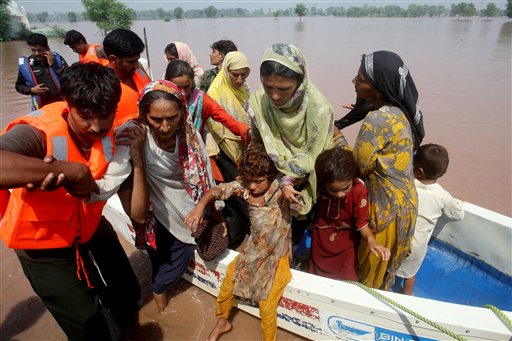
Pakistani volunteers help villagers rescued from flooded villages in Chiniot, 160 kilometers (99 miles) northwest of Lahore, Pakistan, Tuesday, Sept. 9, 2014. The death toll from floods in Pakistan and India increased on Tuesday as armies in both countries scrambled to help the victims and authorities in Islamabad warned hundreds of thousands to be prepared to flee more flooding in the days ahead. AP
JHANG, Pakistan — Raging monsoon floods sweeping across India and Pakistan have killed more than 400 people, authorities said Tuesday, warning hundreds of thousands more to be prepared to flee their homes as helicopters and boats raced to save marooned victims.
Authorities in Pakistan say the floods, which began Sept. 3, are the worst since massive flooding killed 1,700 people in 2010. Pakistan’s minister for water and power, Khwaja Mohammad Asif, warned parliament that some 700,000 people have been told to leave their homes, which could be inundated in the next four days.
Pakistani and Indian troops have been using boats and helicopters to drop food supplies for stranded families and evacuate victims. However, the challenge of the situation grows as more than 1.5 million people are now affected as the rushing waters have destroyed the homes of thousands of families.
“This is a sad moment for all of us,” Pakistani Prime Minister Nawaz Sharif said, addressing flood victims in the country’s Hafiz district. “These floods came suddenly and no one knew that such a large flood was coming.”
The floods have triggered landslides in the divided Kashmir region, split between the two arch rivals, and caused much devastation in northern and eastern Pakistan.
The rains washed away houses, bridges, communication equipment and crops. Pakistani and Indian troops say they have evacuated more than 60,000 people.
Others have waded through waist-deep water to escape the floods, as women carried household items and children on their shoulders as others dragged their livestock along. On roadsides, families set up makeshift camps. Hundreds of others remain stranded on the rooftops, waving for help to every passing helicopter.
On a road near the village of Jamia Abad in the eastern Pakistani district of Jhang, Naseem Akhtar, 41, said she had gone from one government office to another, trying to get someone to help her husband and other family members who had stayed back in their now-submerged village.
Flood-affected people row boats past partially submerged buildings in floodwaters in Srinagar, India, Tuesday, Sept. 9, 2014. AP
Last time she talked to her husband by phone was on Monday night, when he told her that they were sitting on the roof waiting to be rescued, she said.
“I went to the police, I tried to find a private boat, but nothing, there is no help,” she said.
So far, 231 have died in Pakistan and Pakistan-administered Kashmir, while 200 have been killed in India, officials say.
In Pakistan, the floods are now moving south, said Ahmad Kamal, a spokesman for the country’s National Disaster Management Authority.
The inundated Kashmir region in the northern Himalayas is divided between India and Pakistan and claimed by both. Two of the three wars the countries have fought since their independence from Britain in 1947 have been over controlling it.
The Indian army late Monday airlifted communication equipment to restore telephone and mobile phone links damaged by flood water. Army engineers worked Tuesday to restore communication links.
Both nation’s armies airdropped relief packages to victims that included blankets, food supplies, medicine and drinking water.
Although the rains have stopped, the flood waters are likely to submerge hundreds of more villages. Pakistani authorities braced for worsening conditions as water levels in the Chenab and Indus rivers rose, Kamal said.
Meanwhile, environmental experts in India said extensive deforestation of Kashmir’s mountains has aggravated the damage from the floods.
With the Himalayan hills in Kashmir stripped off their green cover, fast flowing streams were causing soil erosion and flash floods, said Krishnaswamy Srinivas of the Vasudha Foundation, a New Delhi-based environmental advocacy group.